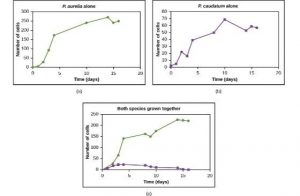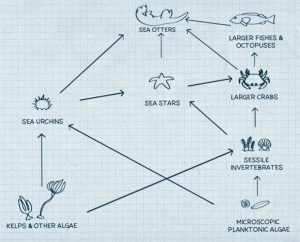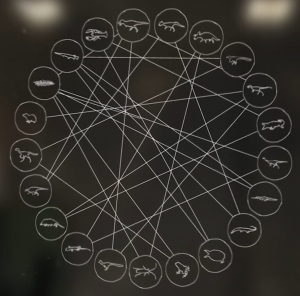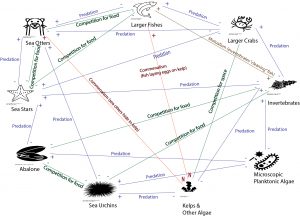10 Species Interactions
Andrea Bierema
Learning Objectives
Students will be able to:
- Define niche.
- Describe types of species interactions.
- Define competitive exclusion and resource partitioning principles.
- Use food webs to infer examples of species interaction within a community.
- Use ecological models to appropriately predict how an abundance of species may impact other species within a community.
Community Ecology
Ecology is studied at different scales and species interactions are part of the “community ecology” scale.
Two-Species Interactions
Community ecology includes the ways in which species interact. Research sometimes focuses on two species of a complex community and the general ways those species interact with one another can be classified by whether the species are positively, negatively, or neutrally impacted. The following video describes the main types of species interactions, with examples. The table below summarizes these types.
| Interaction | Definition | Species A | Species B |
| Mutualism* | A long-term, close association between two species in which both partners benefit | + | + |
| Commensalism* | Organisms of two species use the same limited resource and have a negative impact on each other | + | N |
| Consumption
· Parasitism* · Parasitoidism* · Predation · Herbivory |
One species eats all or part of the body of a member of another species. The consumed species is either killed from the interaction (e.g., predation) or harmed but likely survives (e.g., parasitism) | + | – |
| Competition | Two species “fight” over a resource. Although one species may “win,” it is still negatively impacted by taking part in the competition | – | – |
*These interactions may also be labeled as symbiotic interactions (i.e., symbiosis) if the two species live and interact closely together.
Exercise
Niches and How They Influence Competition
Resources are often limited within a habitat and multiple species may compete to obtain them. All species have an ecological niche in the ecosystem, which describes how they acquire the resources they need and how they interact with other species in the community. The competitive exclusion principle states that two species cannot occupy the same niche in a habitat. In other words, different species cannot coexist in a community if they are competing for all the same resources.
An example of this principle is shown below with two protozoan species: Paramecium aurelia and Paramecium caudatum. When grown individually in the laboratory, they both thrive. When they are placed together in the same test tube (habitat), P. aurelia outcompetes P. caudatum for food, leading to the latter’s eventual extinction.

Exercise
Does competition between two species that share a similar niche always result in one dying off? Try out the Virtual Biology Lab’s simulation of barnacle competition. Once on the website, read through the background information and the tutorial. Then run the experiment- feel free to keep the variables consistent or see what happens when you change them.
Multi-Species Species Interactions
In community ecology, we can examine the interaction of two species or we can think at a larger, more complex scale and examine how many species interact. One way to do so is to start with a food web to identify some of the interactions that are occurring within a community. The following video describes this in more detail using the example of a coastal food web.

Species Interaction Model
The food web is a model that illustrates how energy moves. Models can also be created to show how species interact with one another (beyond predator/prey and competition for food). The following model was introduced in the video. Rather than having each line represent energy movement, they can be labeled with different species interactions such as mutualism. This is a visual way to explain the complexity of species interactions within a community.

For instance, the following model is a complete species interaction model using the species from the video’s Pacific coast food web. Notice how species are now connected with lines rather than arrows. Interactions influence both species involved, while an arrow in a food web indicates the direction that energy moves. Each end of a line is also labeled with a positive (+), negative (-), and neutral (N), indicating how the species is impacted by the interaction. These symbols align with the symbols used in the interactions table shown toward the beginning of the chapter. For instance, in looking at the lines/interactions labeled as “competition for food,” both species are labeled as being negatively impacted by placing a negative on each side of the line.
The “predation” and “competition for food” interactions align with the food web. Food webs allude to predation interactions and if species are eating the same species, then they are likely competing for the food source. The rest of the interactions labeled are from outside research, rather than from studying the food web.

Attribution
This chapter is a modified derivative of the following articles:
“Community Ecology” by OpenStax College, Biology 2e, CC BY 4.0. Access for free at https://openstax.org/books/biology-2e/pages/1-introduction
“Interactions in Communities” by Khan Academy, CC BY-NC-SA 4.0.
Media Attributions
- Competitive Exclusion © OpenStax is licensed under a CC BY (Attribution) license
- Food web © Khan Academy adapted by Andrea Bierema is licensed under a CC BY (Attribution) license
- Species Interaction Model © Khan Academy adapted by Andrea Bierema is licensed under a CC BY (Attribution) license
- Species Interaction Web © Andrea Bierema

